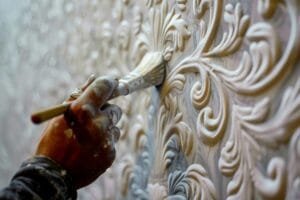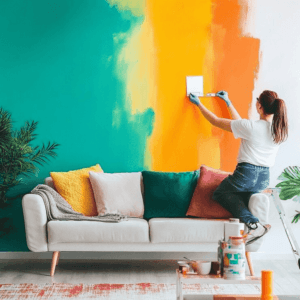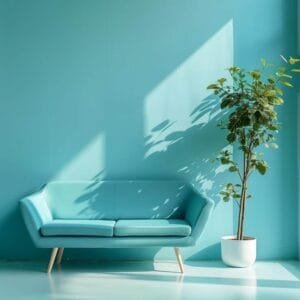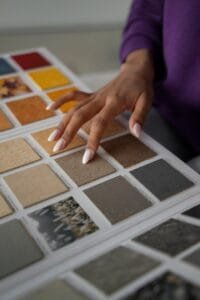Introduction to Unique Wall Texture
Wall textures have emerged as a prominent trend in contemporary interior design, offering a creative means to elevate the aesthetic appeal of living spaces. Often regarded as an art form, wall textures enhance the ambiance of a room by adding depth and dimension that flat, painted surfaces cannot provide. With an increasing focus on individuality and personalization in home decors, unique wall textures are becoming integral to design strategies aimed at creating visually captivating environments.
The role of textures in interior design extends beyond mere decoration. They serve as the backbone of a room’s character, influencing the overall style and feel of a home. Whether it is through the roughness of reclaimed wood, the sleekness of polished concrete, or the softness of fabric panels, different textures can evoke various moods and sensations. For instance, a rustic wall texture can impart warmth and coziness, while a glossy finish can convey a sense of modern elegance. This versatility makes textures essential tools for designers seeking to construct a coherent visual narrative within a space.
Moreover, unique wall textures can effectively function as focal points, drawing attention and serving as conversation starters. They allow homeowners to express their personal tastes while contributing to a cohesive design theme. By selecting sophisticated textures, individuals can redefine their spaces, moving away from traditional techniques. Ultimately, wall textures offer a realm of possibilities, transforming ordinary walls into extraordinary features that resonate with the personality of a home and evoke an emotional connection with its inhabitants.

The Benefits of Adding Texture to Your Walls
Incorporating texture into wall designs offers a myriad of advantages that can significantly enhance interiors. Textured walls provide depth and visual interest, transforming an otherwise mundane space into an inviting and engaging environment. By adding layers to a flat surface, wall textures create a dynamic interplay of light and shadow, which can draw the eye and imbue spaces with a sense of richness.
Furthermore, the psychological impact of textured walls should not be overlooked. The choice of texture can influence the mood of a room; for instance, soft, wavy patterns often evoke feelings of calmness and relaxation, making them ideal for spaces such as bedrooms or reading nooks. Conversely, sharper or rougher textures can energize a room, promoting creativity and activity, which may be more appropriate for office spaces or creative studios.
From a functional standpoint, textured walls contribute positively to acoustics. They can help absorb sound, reducing echo and creating a more comfortable auditory environment. This is particularly beneficial in large rooms or areas with high ceilings, where sound can bounce off flat surfaces and create unwanted noise. Textures can be utilized to break up sound waves, fostering a more serene atmosphere perfect for conversation or relaxation.
Another compelling benefit of employing wall textures is their ability to camouflage imperfections. Uneven surfaces, blemishes, or minor damage can often detract from the overall aesthetic of a space. By integrating texture, these flaws can be cleverly concealed, resulting in a polished appearance without the need for extensive repairs.
Ultimately, adding texture to walls serves both aesthetic and functional purposes, enhancing interior spaces in meaningful ways, and making it a worthwhile consideration in any design project.

Natural Materials for Organic Textures
Integrating natural materials into interior design can significantly enhance the warmth and character of a space. Wood, stone, and bamboo are prime examples of elements that can create captivating organic textures, giving walls a unique and inviting appearance. Each material carries its own aesthetic appeal and can be tailored to fit various design styles, from rustic to modern.
Wood is a versatile material that adds depth and warmth to any environment. When utilized for wall textures, it can take many forms, such as reclaimed barn wood paneling, which offers a rustic feel, or smooth, contemporary wood slats that resonate with modern aesthetics. In a rustic setting, wooden beams may be prominently featured, while in minimalist designs, sleek wooden panels can serve as a subtle yet sophisticated backdrop.
Stone is another exquisite option for achieving organic textures in wall design. Using natural stone veneers or full stone walls can introduce an earthy, grounded feel to interiors. For instance, a stacked stone feature wall in a living room can evoke a cozy mountain lodge ambiance, whereas polished marble in a bathroom adds a touch of luxurious refinement. The variety of stone types, such as slate, granite, or limestone, allows for customization, enabling designers to blend textures and colors that harmonize with their overall vision.
Bamboo, often appreciated for its sustainability, offers a unique approach to wall textures. It can be applied in myriad ways, from bamboo wall panels providing a contemporary twist on traditional materials to intricate woven designs that bring an exotic flair. Integrating bamboo into a space can create a serene, calming atmosphere while simultaneously making an eco-friendly statement.
By thoughtfully incorporating these natural materials, homeowners and designers can significantly enhance the aesthetic appeal of their interiors, celebrating the beauty and innate texture of the environment while maintaining a cohesive style throughout the space.

Creative Paint Techniques for Unique Texture
Painting offers an array of opportunities to introduce distinctive textures to your walls without the necessity of additional materials. Various creative techniques can achieve striking effects that elevate the overall aesthetic of any space. Among these, sponge painting, rag rolling, and stippling are popular methods that yield impressive results.
Sponge painting involves using a natural or synthetic sponge to apply paint to the wall. This technique allows for the creation of a soft, mottled finish that can effectively mimic the look of stone or clouds. When selecting colors for sponge painting, consider choosing a base color that complements your decors, followed by a slightly contrasting color that can add depth. It is advisable to apply the colors gradually, building up the texture layer by layer.
Rag rolling, another technique, utilizes a rag or cloth to create an irregular pattern. This technique is particularly effective for achieving a weathered, vintage look. Start with a base coat and allow it to dry before rolling on a second color with a rag. The randomness of the rolling motion contributes to a unique finish, and by varying the pressure and the amount of paint on the rag, diverse textures can be accomplished.
Stippling, which involves using a stippling brush or a similar tool, provides a way to create small dots or specks of color on the wall. This can give your walls a more textured feel reminiscent of fine sand or stucco. For stippling, choose a palette of colors in the same tonal family to ensure a seamless integration that adds interest without overpowering the space. A subtle approach is essential for an elegant effect.
Practical tips for successful applications include testing your techniques on a small, inconspicuous area before committing to an entire wall. Additionally, maintaining an organized workspace and preparing your phone and tools appropriately can ensure efficient application. These creative paint techniques offer budget-friendly options for transforming your space while allowing for personal expression and originality.
Stylish Wallpaper and Fabric Options
In recent years, wallpaper has evolved far beyond traditional designs, becoming a popular choice for adding unique textures to interior spaces. The variety of textures available, such as embossed, flocked, and fabric-backed wallpapers, offers homeowners a remarkable opportunity to enhance their decors in diverse and innovative ways. Embossed wallpaper, for instance, features raised patterns that create a tactile surface, capturing light and adding depth to walls. Similarly, flocked wallpaper incorporates soft fibers, which can give rooms a plush feel, thereby transforming an ordinary space into an elegant retreat.
On the other hand, fabric-backed wallpaper combines textile aesthetics with the durability of vinyl, resulting in surfaces that are both stylish and practical. This type of wallpaper is particularly effective in high-traffic areas or spaces prone to moisture, due to its resilience. Moreover, the introduction of bold patterns or soft textures through fabric-backed wallpaper can elevate the overall visual impact of a room while ensuring functionality.
When selecting the right wallpaper or fabric texture, it is essential to consider the purpose of the room. For example, a vibrant, bold pattern might work splendidly in a creative workspace or a playful child’s bedroom, while more subdued textures might be advisable for bedrooms or formal dining areas. It is also advisable to assess the existing decor, color palette, and natural light available in the space, as these factors contribute significantly to the effectiveness of wallpaper and fabric applications. Ultimately, integrating unique textures through careful selection of materials can dramatically enhance the overall aesthetic, providing depth and character to virtually any room.
3D Wall Panels for Modern Appeal
In recent years, 3D wall panels have emerged as a prominent trend in interior design, captivating homeowners and designers alike with their unique ability to add depth and texture to a space. These panels are available in a variety of materials, each offering distinct aesthetic and functional advantages. Common options include wood, plastic, and metal, which provide diverse styles suitable for contemporary or transitional environments.
Wooden 3D wall panels present a warm, organic touch that can enhance the coziness of a room. They are available in various finishes and grains, allowing for personalized design choices that integrate seamlessly with other decor elements. On the other hand, plastic panels offer versatility and can imitate various textures, making them a popular choice for budget-conscious projects. Their lightweight nature also simplifies installation, an essential factor for DIY enthusiasts.
Metal panels, with their sleek and modern appeal, are ideal for those wishing to make a bold statement. These panels often feature intriguing designs that reflect light, creating dynamic visual effects that change throughout the day. Incorporating 3D wall panels can enhance a feature wall, bringing it to life through intricate patterns and shadows. Alternatively, using these panels in an entire room can provide a unified look that elevates the overall ambiance.
When considering the application of 3D wall panels, it is crucial to plan the layout carefully. A well-thought-out design can make the most of the space, whether in a living room, office, or commercial setting. Installation can generally be accomplished with adhesive or mounting hardware, though consulting a professional can ensure a polished and enduring finish. Embracing 3D wall panels can undeniably transform a mundane wall into a focal point, enhancing both functionality and visual appeal in any environment.
Textured Wall Art and Accessories
Incorporating textured wall art and accessories into your home decors can significantly enhance the visual interest of your space without the need for extensive renovations. These elements introduce various physical sensations and depths, transforming flat walls into engaging focal points that invite touch and admiration. Textured wall art can encompass a wide range of materials and styles, providing numerous options for personalization.
For instance, framed textiles such as artisan quilts or embroidered pieces can be showcased as art. These create a warm and inviting atmosphere, evoking a sense of comfort. Woven art pieces made from natural fibers, like jute or ma crame, can also add a rustic touch, blending seamlessly with bohemian or coastal themes. Sculptural elements like wall-mounted ceramics or metal art provide a striking contrast to conventional picture frames, adding an extra layer of dimensionality to your walls.
Curating a gallery wall with these textured pieces requires thoughtful planning to achieve a cohesive look. Start by selecting a color palette that complements your existing decors, ensuring each piece harmonizes with one another. Mix different art forms, such as textiles, ceramics, and metalwork, while maintaining a balanced distribution of visual weight. This balance creates a sense of flow across the wall. Additionally, consider varying the size and placement of the art to maintain interest; larger pieces can anchor the display while smaller components fill in gaps.
Finally, don’t forget the importance of lighting; strategically placed lights can draw attention to the textures and intricate details of your selected pieces. By thoughtfully incorporating textured wall art and accessories, you can effortlessly elevate the aesthetic of your interiors, making them more dynamic and inviting.

DIY Texture Ideas for Budget-Friendly Makeovers
Transforming your space with unique wall textures does not have to be costly. With creativity and a few basic materials, you can achieve stunning results through simple DIY projects. Here are some inventive ideas to enhance your walls while staying within budget.
1. Fabric Wall Art: Utilize leftover fabric scraps to create a textured wall installation. Cut the fabric into various shapes and sizes, then adhere them to your wall using a staple gun or fabric glue. This approach adds depth and warmth, creating an inviting atmosphere.
2. Wood Pallet Accent Wall: Repurpose wood pallets into an accent wall by disassembling them and sanding down the boards to achieve a smoother finish. Arrange the planks in various patterns—horizontally, vertically, or even in a herringbone style—for an eye-catching design. Secure them to the wall using screws or nails for durability.
3. Stenciled Textures: Make use of stencils to create textured designs on your wall. Choose a pattern that suits your style and apply a thick coat of paint or a textured coating on top of the stencil. Once dry, remove the stencil for a stunning finish that mimics elaborate wallpaper without the expense.
4. Paper Mache Panels: Create unique 3D textures with paper mache panels. Mix water, glue, and torn pieces of newspapers to create a paste. Shape the paste into panels, let them dry thoroughly, and then paint them in your desired color. Attach them to the wall to produce an interesting textured focal point.
5. Cable Knit Wall: Capture the warmth of a cozy sweater by applying a cable knit texture. This effect can be achieved by using a textured paint roller or by gluing fabric with a cable knit pattern on the wall. This will instantly add a touch of softness and sophistication to any room.
These budget-friendly DIY texture ideas not only refresh your space but also showcase your personal style. With creativity and resourcefulness, transforming your walls into a unique canvas can be both enjoyable and financially manageable.

Conclusion: Choosing the Right Texture for Your Space
Choosing the right wall texture is an essential aspect of interior design that can significantly impact the overall ambiance of a room. Wall textures not only influence the aesthetic appeal of a space but also reflect personal style and functional needs. When selecting a texture, it is crucial to consider how it aligns with your existing color palette and overarching design theme, as this can create a harmonious living environment that feels cohesive and inviting.
Unique wall textures, such as stucco, shiplap, or even modern 3D panels, offer ample opportunities to express individuality. Each texture serves a distinct function; for instance, rough textures can add depth and interest, while smoother finishes may evoke a more contemporary feel. Therefore, understanding the characteristics of different wall textures can help make informed decisions that elevate your home decors, ensuring that every element contributes to the desired atmosphere.
Moreover, functionality plays a vital role in texture selection. Certain textures can help camouflage imperfections on walls, while others may enhance acoustics or provide insulation benefits. It’s essential to evaluate how the various textures will perform in your specific environment, especially in high-traffic areas or spaces subject to moisture, like kitchens and bathrooms. This consideration will not only help achieve a beautiful finish but also promote durability and ease of maintenance.
In conclusion, selecting the right wall textures can transform your space into a unique expression of your style. By carefully considering both aesthetic and functional aspects, you can ensure that the textures you choose not only complement but elevate your decors, creating an atmosphere that truly embodies your personality and enhances your living experience.


